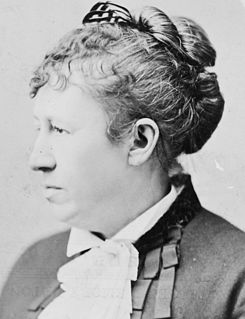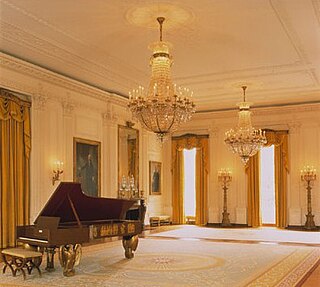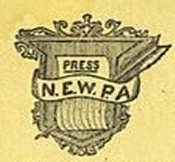
In the United States, Flag Day is celebrated on June 14. It commemorates the adoption of the flag of the United States on June 14, 1777, by resolution of the Second Continental Congress. The Flag Resolution, passed on June 14, 1777, stated: "Resolved, That the flag of the thirteen United States be thirteen stripes, alternate red and white; that the union be thirteen stars, white in a blue field, representing a new constellation."

Julia Boggs Grant was the First Lady of the United States and wife of Ulysses S. Grant. Her time as First Lady marked a turning point in her life, when she became a national figure. Her memoirs, The Personal Memoirs of Julia Dent Grant were published in 1975.

Edith Kermit Roosevelt was the second wife of President Theodore Roosevelt and served as the first lady of the United States during his presidency from 1901 to 1909. She also served as the second lady of the United States in 1901. Roosevelt was the first first lady to employ a full-time, salaried social secretary. Her tenure resulted in the creation of an official staff, and her formal dinners and ceremonial processions served to elevate the position of first lady.
The National Day of Prayer is an annual day of observance held on the first Thursday of May, designated by the United States Congress, when people are asked "to turn to God in prayer and meditation". The president is required by law to sign a proclamation each year, encouraging all Americans to pray on this day.

Finland's Independence Day is a national public holiday, and a flag day, held on 6 December to celebrate Finland's declaration of independence from Russia in 1917.

The inauguration of the president of the United States is a ceremony to mark the commencement of a new four-year term of the president of the United States. During this ceremony, some 72 to 78 days after the presidential election, the president takes the presidential oath of office. The inauguration takes place for each new presidential term, even if the president is continuing in office for a second term.

The East Room is an event and reception room in the Executive Residence, which is a building of the White House complex, the home of the President of the United States. The East Room is the largest room in the Executive Residence; it is used for dances, receptions, press conferences, ceremonies, concerts, and banquets. The East Room was one of the last rooms to be finished and decorated, and it has undergone substantial redecoration over the past two centuries. Since 1964, the Committee for the Preservation of the White House has, by executive order, advised the President of the United States and First Lady of the United States on the decor, preservation, and conservation of the East Room and other public rooms at the White House.

The Green Room is one of three state parlors on the first floor of the White House, the home of the President of the United States. It is used for small receptions and teas. During a state dinner, guests are served cocktails in the three state parlors before the president, first lady, and a visiting head of state descend the Grand Staircase for dinner. The room is traditionally decorated in shades of green. The room is approximately 28 by 22.5 feet. It has six doors, which open into the Cross Hall, East Room, South Portico, and Blue Room.

The China Room is one of the rooms on the Ground Floor of the White House, the home of the President of the United States. The White House's collection of state china is displayed there. The collection ranges from George Washington's Chinese export china to Barack Obama's blue and white themed collection. Almost all administrations are represented with a collection however a few have not created one; most recently the Trump administration failed to have a collection created and instead mainly used the china designed by Hillary Clinton during her time as First Lady. The room is primarily used by the first lady for teas, meetings, and smaller receptions.

A state banquet is an official banquet hosted by the head of state in his or her official residence for another head of state, or sometimes head of government, and other guests. Usually as part of a state visit or diplomatic conference, it is held to celebrate diplomatic ties between the host and guest countries. Depending on time of the day, it may be referred to as a state dinner or state lunch. The size varies, but the numbers of diners may run into the hundreds.

Thanksgiving is a federal holiday in the United States, celebrated on the fourth Thursday of November. It is sometimes called American Thanksgiving to distinguish it from the Canadian holiday of the same name. It originated as a harvest festival, and the centerpiece of Thanksgiving celebrations remains Thanksgiving dinner. The dinner traditionally consists of foods and dishes indigenous to the Americas, namely turkey, potatoes, stuffing, squash, corn (maize), green beans, cranberries, and pumpkin pie. Other Thanksgiving customs include charitable organizations offering Thanksgiving dinner for the poor, attending religious services, watching parades, and viewing football games. In American culture Thanksgiving is regarded as the beginning of the fall–winter holiday season, which includes Christmas and the New Year.

William McKinley, the 25th President of the United States, was shot on the grounds of the Pan-American Exposition at the Temple of Music in Buffalo, New York, on September 6, 1901, six months into his second term. He was shaking hands with the public when anarchist Leon Czolgosz shot him twice in the abdomen. McKinley died on September 14 of gangrene caused by the wounds. He was the third American president to be assassinated, following Abraham Lincoln in 1865 and James A. Garfield in 1881.
The following are minor or locally celebrated holidays related to the American Revolution.

The White House Hanukkah Party is an annual reception held at the White House and hosted by the U.S. President and First Lady to recognize and celebrate the Jewish festival of Hanukkah. The tradition was established in 2001, during the administration of George W. Bush. The guest list includes hundreds of American Jewish politicians, organization heads, and school and yeshiva deans.

Washington's Birthday is a federal holiday in the United States celebrated on the third Monday of February in honor of George Washington, the first president of the United States, who was born on February 22, 1732. The Uniform Monday Holiday Act of 1971 moved this holiday to the third Monday, which can occur from February 15 to 21, inclusive.

The White House Passover Seder was an annual private dinner held at the White House on the Jewish holiday of Passover during the presidency of Barack Obama. Obama initiated it in 2009 for his family, staff members, friends, and their families. The gathering recited the Passover Haggadah, discussed the themes of the Passover Seder and their relation to current events, and partook of a holiday-themed meal. Obama hosted and attended the Seder each year from 2009 to 2016. It was the first Passover Seder to be conducted by a sitting U.S. president in the White House.

Atatürk Museum Mansion is a historic house museum in Ankara, Turkey. It was the residence of President Mustafa Kemal Atatürk between 1921 and 1932, during the early years of the Republic. The museum is situated on Çankaya St. within the Çankaya Campus. It is situated right beside the Çankaya Mansion.

The New England Woman's Press Association (NEWPA) was founded by six Boston newspaper women in 1885 and incorporated in 1890. By the turn of the century it had over 150 members. NEWPA sought not only to bring female colleagues together and further their careers in a male-dominated field, but to use the power of the press for the good of society. The group raised funds for charity and supported women's suffrage and other political causes.

Jessie De Priest was a former music teacher married to Oscar Stanton De Priest, the first African American to be elected to the United States Congress in the 20th century. Jessie De Priest was the first African American wife of a U.S. Congressman who served in the 1900s. She is best known for her involvement in an incident known as the "Tea at the White House". First Lady Lou Henry Hoover invited De Priest to the traditional tea along with several other Congressmen's wives, resulting in racially-motivated backlash from media outlets and the public.

















